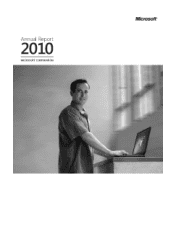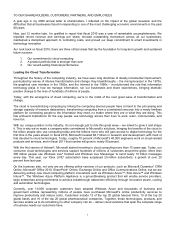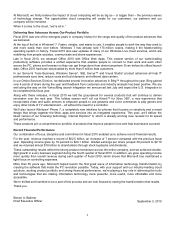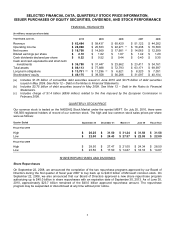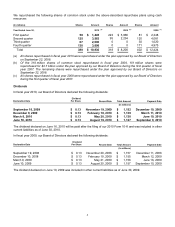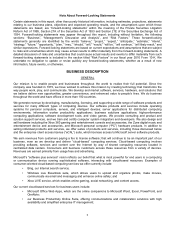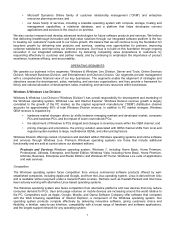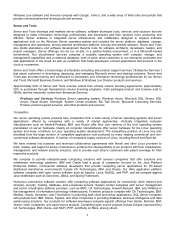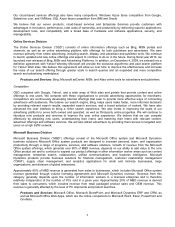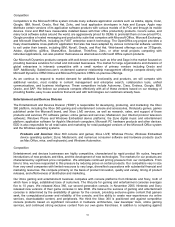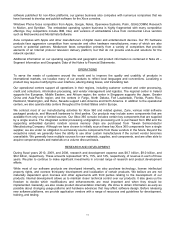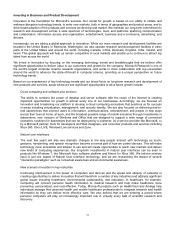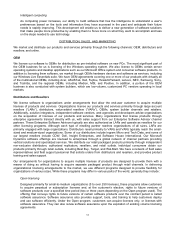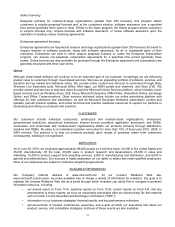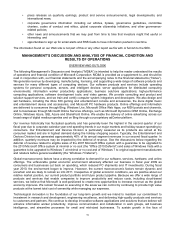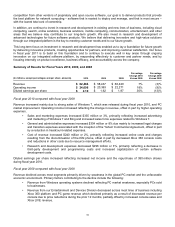Microsoft 2010 Annual Report Download - page 7
Download and view the complete annual report
Please find page 7 of the 2010 Microsoft annual report below. You can navigate through the pages in the report by either clicking on the pages listed below, or by using the keyword search tool below to find specific information within the annual report.
6
Note About Forward-Looking Statements
Certain statements in this report, other than purely historical information, including estimates, projections, statements
relating to our business plans, objectives and expected operating results, and the assumptions upon which those
statements are based, are “forward-looking statements” within the meaning of the Private Securities Litigation
Reform Act of 1995, Section 27A of the Securities Act of 1933 and Section 21E of the Securities Exchange Act of
1934. Forward-looking statements may appear throughout this report, including without limitation, the following
sections: “Business”, “Management’s Discussion and Analysis”, and “Risk Factors.” These forward-looking
statements generally are identified by the words “believe,” “project,” “expect,” “anticipate,” “estimate,” “intend,”
“strategy,” “future,” “opportunity,” “plan,” “may,” “should,” “will,” “would,” “will be,” “will continue,” “will likely result,” and
similar expressions. Forward-looking statements are based on current expectations and assumptions that are subject
to risks and uncertainties which may cause actual results to differ materially from the forward-looking statements. A
detailed discussion of risks and uncertainties that could cause actual results and events to differ materially from such
forward-looking statements is included in the section titled “Risk Factors” in our fiscal year 2010 Form 10-K. We
undertake no obligation to update or revise publicly any forward-looking statements, whether as a result of new
information, future events, or otherwise.
BUSINESS DESCRIPTION
GENERAL
Our mission is to enable people and businesses throughout the world to realize their full potential. Since the
company was founded in 1975, we have worked to achieve this mission by creating technology that transforms the
way people work, play, and communicate. We develop and market software, services, hardware, and solutions that
we believe deliver new opportunities, greater convenience, and enhanced value to people’s lives. We do business
throughout the world and have offices in more than 100 countries.
We generate revenue by developing, manufacturing, licensing, and supporting a wide range of software products and
services for many different types of computing devices. Our software products and services include operating
systems for personal computers, servers, and intelligent devices; server applications for distributed computing
environments; information worker productivity applications; business solutions applications; high-performance
computing applications; software development tools; and video games. We provide consulting and product and
solution support services, and we train and certify computer system integrators and developers. We also design and
sell hardware including the Xbox 360 gaming and entertainment console and accessories, the Zune digital music and
entertainment device and accessories, and Microsoft personal computer (“PC”) hardware products. In addition to
selling individual products and services, we offer suites of products and services, including those discussed below
and the enterprise client access license (“eCAL”) suite, which licenses access to Microsoft server software products.
We earn revenues from customers paying a fee to license software; that will continue to be an important part of our
business, even as we develop and deliver “cloud-based” computing services. Cloud-based computing involves
providing software, services and content over the Internet by way of shared computing resources located in
centralized data centers. Consumers and business customers access these resources from a variety of devices.
Revenues are earned primarily from usage fees and advertising.
Microsoft’s “software plus services” vision reflects our belief that what is most powerful for end users is a computing
or communication device running sophisticated software, interacting with cloud-based resources. Examples of
consumer-oriented cloud-based computing services we offer currently include:
• Bing, our Internet search service;
• Windows Live Essentials suite, which allows users to upload and organize photos, make movies,
communicate via email and messaging and enhance online safety; and
• Xbox LIVE service, which enables online gaming, social networking, and content access.
Our current cloud-based services for business users include:
• Microsoft Office Web Apps, which are the online companions to Microsoft Word, Excel, PowerPoint, and
OneNote;
• our Business Productivity Online Suite, offering communications and collaboration solutions with high
availability and simplified enterprise IT management;

